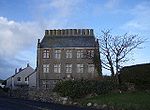Piel Island

Piel Island lies in Morecambe Bay , around 1⁄2 mile (800 metres) off the southern tip of the Furness peninsula in the administrative county of Cumbria, England. It is one of the Islands of Furness, three of which sit near to Piel at the mouth of Walney Channel. The island is the location of Piel Castle, built by the monks of Furness Abbey in the fourteenth century. Historically within Lancashire, the island today is owned by the town of Barrow-in-Furness, having been given to the people by the Duke of Buccleuch in 1922. The Borough Council's administrative duties also include the selection of the "King" of Piel, who is the landlord of the island's public house, the Ship Inn. Piel is about 26 acres (11 hectares) in size. The landlord and their family are usually the only permanent residents, though there are eight old fishermen's cottages which are used by sailors or as second homes.
Excerpt from the Wikipedia article Piel Island (License: CC BY-SA 3.0, Authors, Images).Piel Island
Piel Street,
Geographical coordinates (GPS) Address Website Nearby Places Show on map
Geographical coordinates (GPS)
| Latitude | Longitude |
|---|---|
| N 54.063888888889 ° | E -3.175 ° |
Address
Piel Castle (Pile of Fouldrey)
Piel Street
LA13 0QJ
England, United Kingdom
Open on Google Maps







